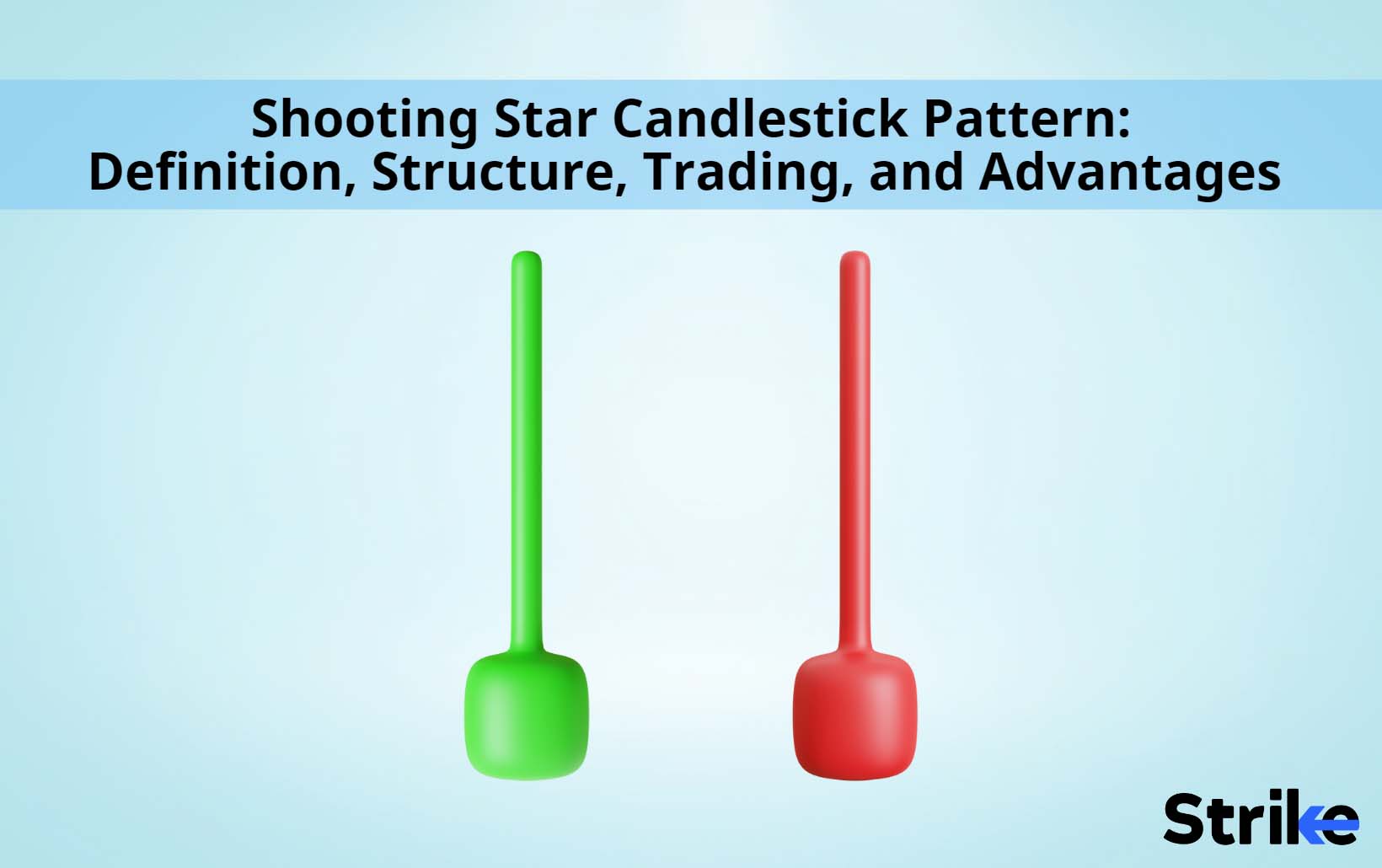
A shooting star candlestick is a type of price chart pattern that is created when a security’s price increases initially after opening and then falls close to the opening price before the market closes. A shooting star candlestick is structured by a small body, a long upper shadow or wick indicating the increase in price and buying pressure and a short lower shadow or wick indicating the price drop. Shooting star candlesticks signify the start of a bearish market trend where the prices start to decline. Bearish trend reversals are, however, confirmed after analyzing the two or three consecutive candlestick patterns that follow a shooting star, to ensure maximum certainty.
Shooting star candlestick patterns are used in technical analysis by traders to predict upcoming bearish trends. The decline in the price is considered a signal that the sellers have taken over the market. To trade with shooting stars, investors need to focus on three main points including finding the entry point, using stop-loss and deciding on the target profit. Traders commonly wait for the consecutive candlestick pattern when they spot a shooting star pattern to confirm the price declines. They consider options such as selling or shorting if the pattern following a shooting star also indicates a price drop. Shooting star patterns, thereby, help traders make trading decisions based on upcoming market trends.
The three main advantages of shooting stars include the ease of spotting and understanding them and their usefulness in identifying upcoming price trends. The two main disadvantages of shooting star patterns include their tendency to produce false signals from time to time and the need to use more than one candlestick to confirm the price trend. There are totally 35 candlestick patterns of which the seven main ones include the morning star, hammer, inverted hammer, piercing pattern, shooting star, hanging man, and doji.
What is a Shooting Star Candlestick?
A shooting star candlestick is a price pattern that is formed when the price of security opens and first advances and then declines and falls to a price close to the opening price. Shooting star candlestick patterns signal the start of a price reversal where the trend begins to turn bearish. Shooting star candlesticks comprise a small body, a long upper tail and a short lower tail. The lower tail is at times absent in some shooting stars. The image below depicts a shooting star candlestick pattern.
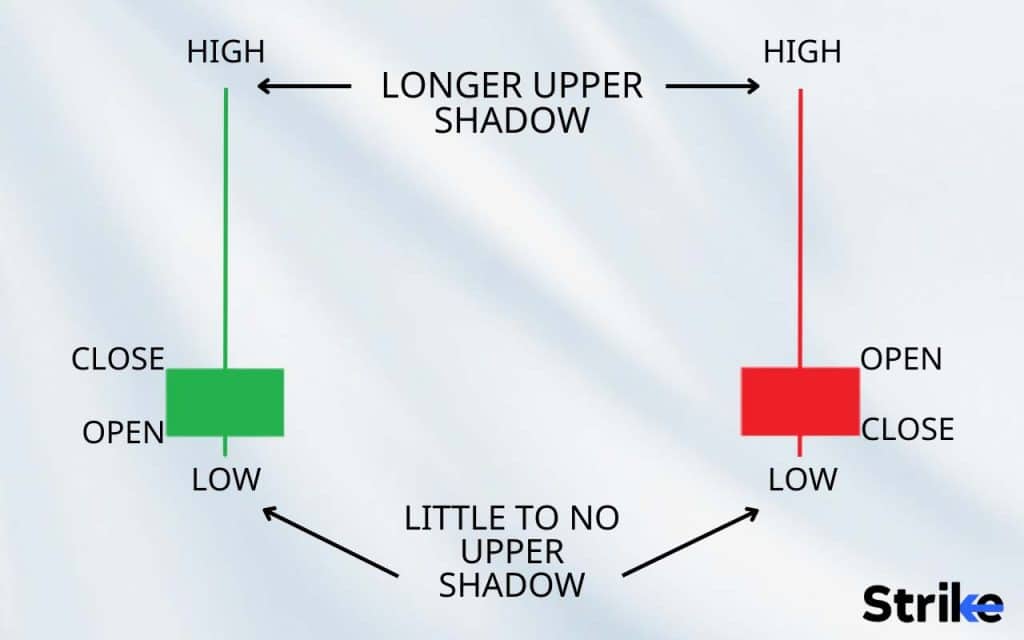
The image shows the body of the candlestick, the long upper tail or wick as well as the short lower wick or tail. The body of the shooting star is the wide part of the candlestick, which represents the difference between the opening and closing prices of the security. The long upper wick represents the advancing price from the opening price to the highest price for the day. The lower short wick represents the drop in price at the market close to the level close to or below the opening price. A shooting star’s body is either green or red in colour. The green body signifies that the opening price is lower than the closing price, although the two are very close. The red body signifies that the opening price is greater than the closing price. While reading a shooting star candlestick pattern, investors and traders must pay attention to three aspects including the active price trend at the opening of the shooting star, the price drop that follows in the latter half of the day, and the need to confirm the trend using the candlesticks from the following days.
The pattern formed by a shooting star candlestick during the price drop resembles the rapid movement of a shooting star when it comes crashing into the earth’s atmosphere before burning up.
Shooting star candlestick patterns tell traders about upcoming bearish trends in the market. Traders who spot shooting star patterns in the candlestick price charts, wait for the following pattern the next day. Traders consider the market trend bearish if the pattern that follows a shooting star candlestick pattern also reflects a price drop. Traders also make trading decisions based on the shooting star patterns. Traders sell or resort to shorting if the patterns following a shooting star pattern also indicate a price drop.
How is a Shooting Star Candlestick Pattern structured?
A shooting star candlestick is structured with a real body, a long upper tail or wick and a short or no lower tail or wick. A shooting star candlestick’s structure represents the rapid downward movement of the price toward the close of the market. For a candlestick pattern to be considered a shooting star, the upper wick must be at least twice the length of the body of the candlestick.
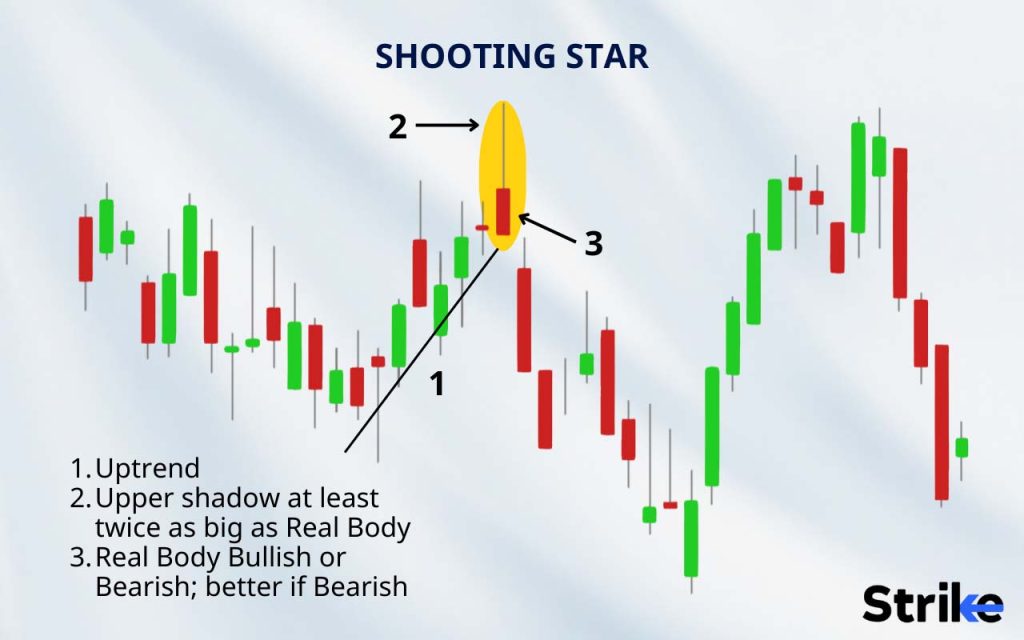
the price chart above depicts the structure of the shooting star candlestick pattern. An initial uptrend is seen in the area marked (1), as the prices are on the increase. At the end of the uptrend, a shooting star candlestick pattern with a long upper wick is visible. The long wick or shadow that is marked as (2) is at least twice the size of the body of the candlestick. The body of the candlestick that is marked as (3) is red as the opening price is more than the closing price.
A shooting star opens with an advancing price as there is high demand for the security and buyers continue to purchase the security. Towards the end of the day, however, the price is driven down to a level below or close to the opening price. The long upper wick, which is also referred to as a tail or shadow, represents the transition from buying pressure to selling pressure, as buyers who made purchases during the day lose their gains with the decreasing price. A short lower shadow, wick or tail is formed when the sellers push the price below the opening price. Shooting star patterns are of two types red shooting stars and green shooting stars.
What does Red Shooting Star indicate?
A red shooting star indicates that the closing price of the security is below its opening price. The red shooting star candlestick is considered a more powerful indicator of an oncoming bearish trend as the closing price is at the very end of the candlestick.
What does Green Shooting Star tell?
A green shooting star indicates that the closing price of a security is above its opening price. However, the range between the opening and closing price is not very large and the closing price of the security remains close to the opening price. Green shooting stars also signify bearish trends, although they are not as powerful as red shooting stars.
When does Shooting Star Candlestick Pattern occur?
A shooting star candlestick pattern occurs when the price of a security increases significantly after opening and then drops rapidly towards the market close to a price level that is close to the opening price. Shooting star candlestick patterns mark the end of an uptrend and signal an upcoming bearish trend.
How often does Shooting Star Candlestick Pattern happen?
Shooting star candlestick patterns are seen every time an uptrend reverses and turns bearish. The occurrence of bearish trends can take anything from a few months to a few years, depending on other economic and market conditions including slowing economies, wars, geopolitical crises etc.
How to read Shooting Star Candlestick Pattern in Technical Analysis?
In the technical analysis of a shooting star candlestick pattern, there are three things to be considered. The image below depicts the three things that are to be kept in mind while reading the shooting star candlestick pattern in technical analysis.
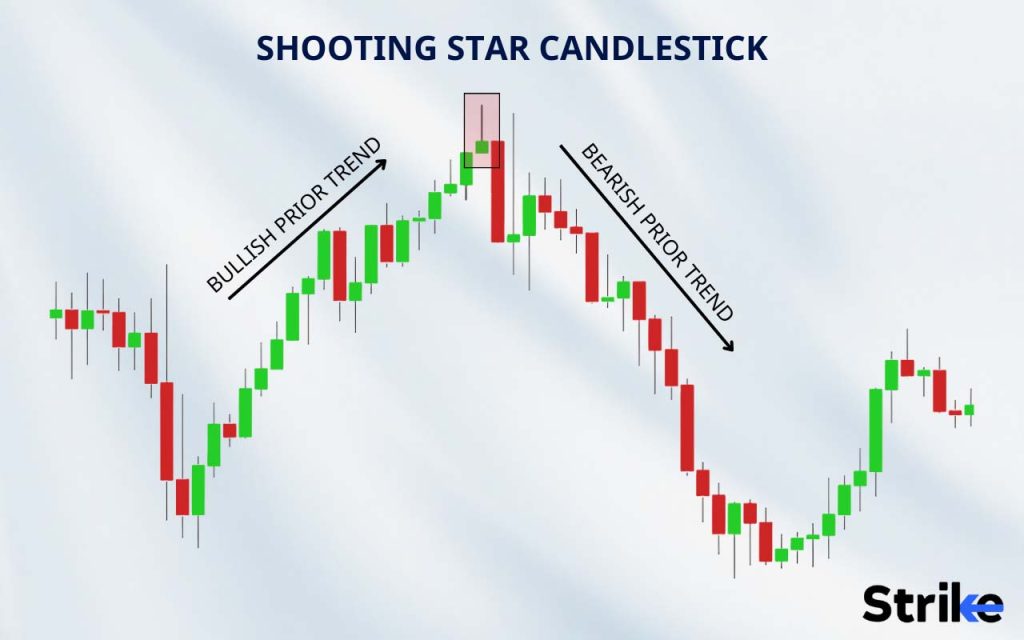
Firstly, investors and traders must take note of the price advance. As the image shows, a shooting star occurs at the end of a bullish prior trend. In a shooting star candlestick pattern, the price advances considerably after the market opening. The sharp price increase is indicative of the existence of a buying pressure that has been present for the past bullish period. As the number of buyers increases the wick of the candlestick gets longer.
Secondly, investors and traders must pay attention to the rapid price drop that occurs later in the day. As seen in the image above, in a shooting star candlestick pattern, the price starts to drop in the latter half of the day after a significant advance. The price then, drops to a level very close to the opening price of the security, making the body of the candlestick very small. The decline in prices is caused by the increase in the number of sellers who push the price of the security to a level close to the opening price for the day. The long wick of the shooting star stands for the sellers who took over the buyers over the progress of the day.
Thirdly, investors and traders reading a shooting star candlestick pattern need to confirm the trend reversal. For trend confirmation, investors and traders must look out for the candlestick patterns that follow the shooting star patterns. As the image above depicts, the candlesticks that follow the shooting star pattern depict a price decline with declining closing prices. The trend is considered to have turned bearish only if the pattern following the shooting star also depicts a price drop. In such cases, shooting star candlestick patterns are signals of upcoming bearish price reversals. The accuracy and reliability of shooting star candlestick patterns depend on the candlestick patterns that follow the shooting star candlestick pattern.
How accurate is the Shooting Star Candlestick Pattern in Technical Analysis?
The shooting star candlestick is considered one of the most reliable candlestick patterns. The accuracy of shooting star candlestick patterns varies depending on the candlestick patterns that follow the shooting star candlestick. The trend is confirmed to be a bearish trend only if the candlestick pattern that follows a shooting star depicts a price decline. Sometimes the candlestick pattern that follows a shooting star pattern shows a price increase. In such cases, the shooting star is considered a false signal. A price increase that immediately follows a shooting star could also imply the formation of a resistance area around the candlestick. A resistance area refers to a point on the price chart that a security experiences difficulty in breaking and moving above in a specified time frame.
How reliable is a Shooting Star in Technical Analysis?
Shooting star candlesticks are one of the most reliable candlestick patterns. However, the upcoming trend is confirmed only after analyzing the pattern that follows the shooting star. The trend is considered bearish if the candlestick pattern following the shooting star shows a downward movement in terms of price. However, there are scenarios where the candlestick pattern following the shooting star shows an upward price movement.
In such cases, the shooting star is considered to be a false signal. Investors and traders must ideally analyse the patterns that follow a shooting star for three days, to make careful and well-thought-out trading decisions.
How to Trade with Shooting Star Candlestick Pattern in Stock Market?
The three main criteria that investors and traders must keep in mind while trading with shooting star candlestick patterns is listed below along with a price chart that depicts the steps to follow while trading with shooting star candlestick patterns.
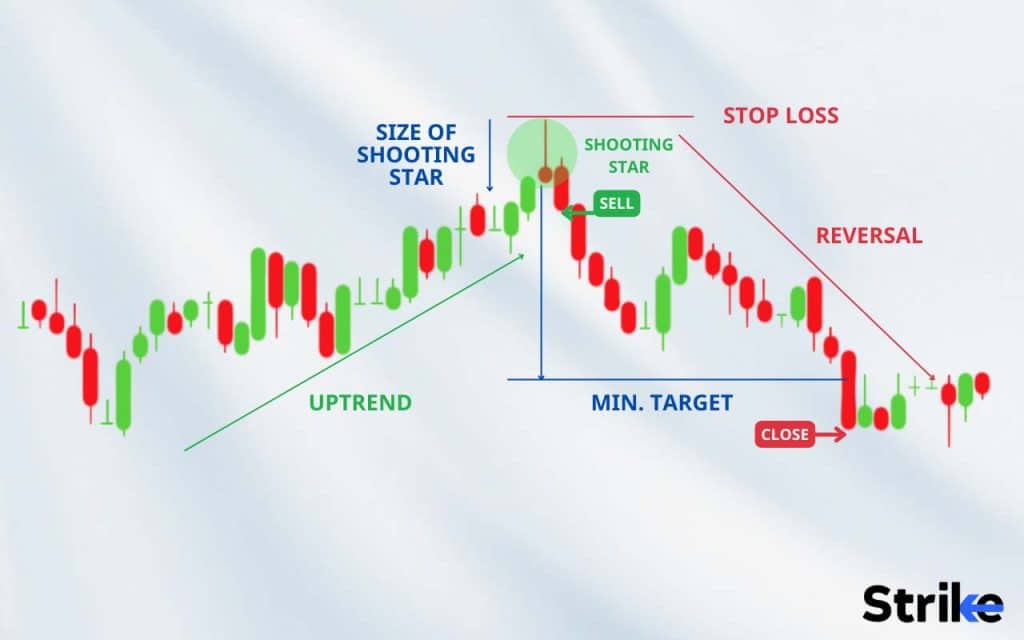
- Deciding on the entry point
The first thing to be kept in mind while trading with shooting star candlesticks is deciding on the entry point. It is important that traders check the active price trend. As seen in the image above, a shooting star occurs at the end of a bullish uptrend. Investors must enter the trade only when the trend is bullish and the security price is on the increase. The shooting star pattern must be confirmed once an active bullish trend has been identified. To confirm the shooting star pattern, investors must identify a candlestick with a small body and a long wick and wait for the candlestick to drop below the lowest price point of the shooting star’s body. The image above depicts what a shooting star looks like with its small real body and long upper shadow and wick.
- Using a stop-loss order
The second key point to remember while trading with the shooting star candlestick pattern is to use a stop-loss order. A stop-loss order is a pre-decided order that states that a security can be either bought or sold when it reaches a certain price known as the stop price. Stop-loss orders help to reduce the loss from trading by locking in a profitable position. It is advisable to enter stop-loss orders while trading with shooting stars as it protects the investors from incurring huge losses when the price plummets. As shown in the image above, a stop loss order can be placed right above the upper wick to minimize losses and gain maximum returns.
- Deciding on profit target
The third key step in trading with shooting star candlestick is to decide on a price target. The price target must be the length of the candlestick pattern to gain maximum returns. As shown in the image the length of the candlestick is measured from the base of the body to the tip of the upper shadow or wick. The minimum target for the trading strategy is kept at three times the length of the entire candlestick, as depicted by the blue arrow in the image above.
While trading with shooting star candlestick patterns selling and shorting are two of the commonly used methods that yield good returns in trading with shooting star candlestick patterns. The ideal time to trade using the shooting star candlestick is when the pattern has been formed after two or three consecutive highs.
When is the best time to Trade using Shooting Star Candlestick Pattern?
The best time to trade using the shooting star candlestick pattern is when the shooting star is formed following two or three days of consecutive highs. The shooting star formed after two or three days of highs as the security price is close to or at the highest price point, within that particular time frame. Trading at such a time can yield maximum profits.
What is an example of a Shooting Star Candlestick Pattern used in Trading?
As an example of how shooting star candlestick patterns are used in trading, let us consider the price chart below.
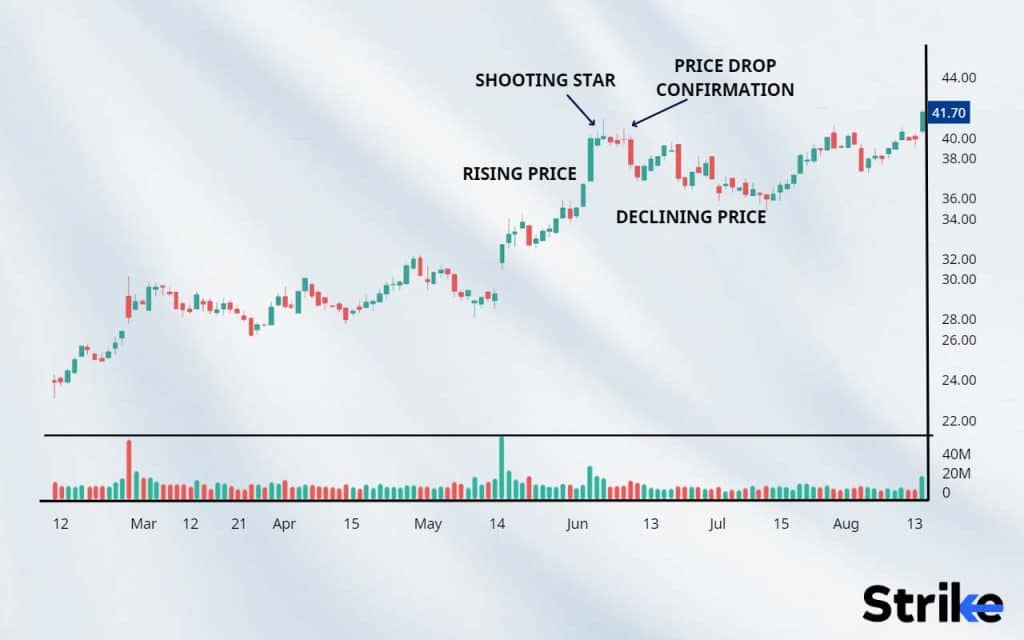
The price chart above shows an increase in prices from the date May 14. The advance is seen to be rapid until the formation of the shooting star in early June. The shooting star is identified by its short body and long upper wick. The shooting star represents the advancing price after a high opening price followed by a decline in the price and a close that is near the opening price. In such a scenario, investors look out for the pattern that follows the shooting star pattern to confirm the bearish trend. In the chart above, the price chart for the day following the shooting star is seen to close at a price point that is lower than that of the shooting star, thereby, confirming the bearish trend. The image shows that the highest point of the shooting star is not crossed by any of the patterns that follow within the given time frame until August. The image also shows that the bearish trend continued for the next month. Investors and traders, thereby, utilise the shooting star as a bearish trend reversal signal. Traders tend to resort to shorting or selling long positions in the face of shooting star patterns. The profits made through trading with shooting star candlesticks depend on the investment strategies adopted and practised by the traders and investors.
Is Shooting Star Candlestick Pattern profitable?
A shooting star candlestick pattern can be profitable depending on the investor or trader in question and the investment strategy adopted by them. Shorting or taking long positions tends to be profitable as long as the investment strategy is developed with sufficient study and analysis. It is advisable to always study the two or three candlestick patterns that follow the shooting star patterns to first confirm the downtrend and eliminate any false signals.
Is a Shooting Star Candlestick Pattern a Bullish Reversal?
No, a shooting star candlestick pattern is a bearish reversal where the pattern starts during the end of a bullish trend where the price starts to decrease into a downward movement.
What are the advantages of a Shooting Star Candlestick?
The three main advantages of shooting star candlesticks are listed below.
- The ease of spotting
The main advantage of shooting star candlestick patterns is the ease of spotting them on the price chart. Shooting star candlesticks can be easily identified from the small body and long upper wick. Traders who are new to trading and beginners also find it easy to spot the shooting star candlestick pattern.
- The ease of understanding
The second main advantage of shooting star candlesticks is their simplicity. Shooting star candlesticks are straightforward patterns that even beginners can comprehend very easily.
- The usefulness in predicting upcoming price trends
The third main advantage of shooting star candlesticks is their usefulness in helping predict upcoming price trends. By using shooting star candlesticks, investors are made aware of upcoming bearish trend reversals and they can use this knowledge to plan their investment and trading strategies accordingly.
The simplicity of the shooting star candlestick pattern is what makes it so easily accessible to new beginner traders. It is the lack of complexity that makes shooting stars a fairly reliable signal of bearish trend reversals.
What are the disadvantages of a Shooting Star Candlestick?
The two main disadvantages of shooting star candlestick patterns are listed below.
- Tendency to produce false signals
The primary disadvantage of shooting star candlesticks is that they are prone to producing false signals. Sometimes, the patterns following the shooting star do not reflect the trend reversal that the shooting star implied. It is to overcome the false signal limitation that most traders prefer to wait for the pattern that follows a shooting star before making trading decisions.
- Need to use more candles to confirm the trend
Another disadvantage of using shoot star candlesticks is that they cannot be used in the isolation. To confirm the bearish trend reversal, more candles are required. Investors who make trading strategies solely based on a single shooting star candlestick pattern expose themselves to the risk of incurring losses through false signals produced.
In order to minimize any losses incurred through the false signals produced by shooting stars, investors and traders use stop-losses. Stop losses help in limiting the risk to a certain level.
What are other Types of Candlestick besides Shooting Stars?
There are more than 40 types of candlesticks which are classified into three main categories including bullish candlestick patterns, bearish candlestick patterns and continuation candlestick patterns.
The first type of candlestick is the bullish candlestick pattern. Bullish candlestick patterns include those candlesticks which signal bullish trend reversals such as hammer, piercing pattern, bullish harami, morning star, inverted hammer, tweezer bottom etc.
The second type is the bearish candlestick pattern. Bearish candlestick patterns are those that signal bearish trend reversals, including hanging man, dark cloud cover, shooting star, evening star, bearish harami, tweezer top etc.
The third type is known as the continuation candlestick pattern. Continuation candlestick patterns represent the continuation of the existing active trend. Examples of continuation candlestick patterns include doji, spinning top, high wave, falling window, rising three methods, falling three methods etc.
Is a Shooting Star a Doji?
A shooting star is not a doji. A shooting star is considered a bearish trend reversal signal. Whereas, a doji is considered a signal of indecision wherein the opening and closing prices lie very close to each other owing to the struggle to control the prices by the bulls and the bears.
In a shooting star, on the other hand, the bears have already taken over the control of the bulls and it is a sign of a bearish trend reversal.
Shooting stars and dojis are not exactly similar in terms of appearance either. In terms of their bodies, shooting stars commonly have a short body with a long upper wick and a short or no lower wick. Doji, on the other hand, has a body that is smaller than that of a shooting star and long upper and lower wicks. Shooting stars are however very similar in appearance to inverted hammer candlesticks.
What is the difference between a Shooting Star Candlestick and an Inverted Hammer Candlestick?
The primary difference between a shooting star candlestick and an inverted hammer candlestick lies in the context in which they appear. Shooting star candlesticks appear at the end of an upward price movement and mark the beginning of a trend reversal to a downward price movement. Inverted hammer candlesticks, on the other hand, appear at the end of a declining price movement and marks the start of a trend reversal to an advancing price movement.




![85 Common Stock Market Terminologies for Dummies [Updated List for 2025] 64 85 Common Stock Market Terminologies for Dummies [Updated List for 2025]](https://www.strike.money/wp-content/uploads/2025/04/Popular-Stock-Market-Terms-for-Beginners-Banner.png)










No Comments Yet.